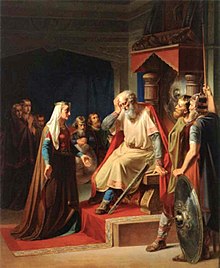Gorm the Old
| Gorm the Old | |
|---|---|

Gorm learns of the death of his son Canute, painting by August Carl Vilhelm Thomsen.
|
|
| King of Denmark | |
| Reign | c. 936 – c. 958 |
| Successor | Harald Bluetooth |
| Spouse | Thyra |
| Issue Detail |
Harald Bluetooth Knut Danaast Gunnhild, Mother of Kings Strut-Harald |
| House | House of Gorm |
| Father | Harthacnut I of Denmark (semi legendary) |
Gorm the Old (Danish: Gorm den Gamle, Old Norse: Gormr gamli, Latin: Gormus Senex), also called Gorm the Languid (Danish: Gorm Løge, Gorm den Dvaske), was the first historically recognized ruler of Denmark, reigning from c. 936 to his death c. 958. He ruled from Jelling, and made the oldest of the Jelling Stones in honour of his wife Thyra. Gorm was born before 900 and died c. 958.
Gorm is the reported son of semi-legendary Danish king Harthacnut. Chronicler Adam of Bremen says that Harthacnut came from Nortmannia to Denmark and seized power in the early 10th century. He deposed the young king Sigtrygg Gnupasson, reigning over Western Denmark. When Harthacnut died, Gorm ascended the throne.
Heimskringla reports Gorm taking at least part of the kingdom by force from Gnupa, and Adam himself suggests that the kingdom had been divided prior to Gorm's time. Gorm is first mentioned as the host of Archbishop Unni of Hamburg and Bremen in 936. According to the Jelling Stones, Gorm's son, Harald Bluetooth, "won all of Denmark", so it is speculated that Gorm only ruled Jutland from his seat in Jelling.
...
Wikipedia
